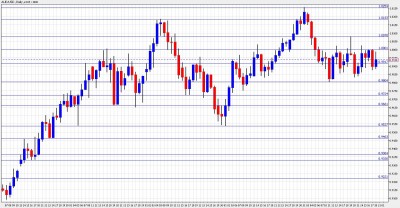After a choppy week, Aussie trades expect a very busy week, with no less than 13 events. The rate decision is the highlight. Here’s an outlook for these events and an updated technical analysis for AUD/USD.
We’ve seen that inflation wasn’t imported from China, easing pressures for a rate hike in Australia. At least it seems that Australia is currently in a safe part of the world, far from the Middle East.
AUD/USD chart with support and resistance lines on it. Click to enlarge:

- NAB Business Confidence: Publication time unknown at the moment. National Bank Australia’ survey of 350 businesses has shown a gradual deterioration in confidence in the past three months, falling from 11 to 6 points. Another drop is expected now, though the number is expected to be positive, showing improving conditions.
- HIA New Home Sales: Publication time unknown at the moment. Australia’s Housing Industry Association printed a drop last month – 0.2% in sales. This was a correction after the jump of 6.1% in the previous month. Another small drop is expected now.
- MI Inflation Gauge: Sunday, 23:30. The Melbourne Institute fills in for the government, that releases official inflation figures only on a quarterly basis. Last month saw a weaker rise, only +0.2% and the same figure is expected now.
- Private Sector Credit: Monday, 00:30. More credit means more economic activity. A surprising rise of 0.3% was recorded last month, showing a stronger economy. The same rise is predicted now. A rise of over 0.5% will boost the Aussie.
- AIG Manufacturing Index: Monday, 22:30. The Australia Industry Group’s PMI-like figure shows that manufacturing has squeezed in the past 4 months, with the score being under 50 points. A small improvement is expected to rise from 46.3 points recorded last month, but not rise above 50.
- HPI: Tuesday, 00:30. After 5 quarters of strong rises in house prices, Australia’s official house prices index hardly moved in Q3, rising only 0.1%. No change is expected in Q4. A drop in prices will hurt the Aussie.
- Chinese Manufacturing PMI: Tuesday, 1:00. Australia’s main trade partner disappointed last month with slower growth in manufacturing – only 53.9 points. This hurt the Aussie. This time, a correction to 54.1 points is predicted. Any result will rock the Aussie.
- Rate decision: Tuesday, 3:30. Following the CPI and PPI reports that have shown that inflation isn’t a threat, and the aforementioned Chinese slowdown, the RBA is expected to leave the interest rate unchanged at 4.75%. There’s a wide consensus about this. The Aussie will move according to the accompanying statement – this could be rather negative following the floods in Queensland, although the overall situation in Australia is still OK.
- Commodity Prices: Tuesday, 5:30. Australia’s export oriented economy is very dependent on prices of commodities. They’re expected to show a rise in January, as most commodities were on the rise.
- AIG Services Index: Wednesday, 22:30. AIG’s second PMI-like figure also shows contraction, very similar to the manufacturing index – 46.4 points. Also here, a small improvement is expected, though no break above 50.
- Building Approvals: Thursday, 00:30. This housing-sector figure always rocks the Aussie, despite its high volatility. After a rise of 8.3% two months ago, approvals fell by 4.2% last time. A small rise of 1.4% is predicted this time.
- Trade Balance: Thursday, 00:30. Though overshadowed by building approvals, this figure can shake the Aussie if it comes out far off expectations. Australia’s surplus is expected to squeeze from 1.93 to 1.64 billion. A figure above 2.5 billion or below 1 billion will be significant.
- RBA Monetary Policy Statement: Friday, 00:30. Glenn Stevens’ RBA releases this important outlook once a quarter. It includes an economic outlook for the next months. The sentiment expressed in the report, will be felt in the Aussie as well. Comments about jobs will probably take the center stage.
* All times are GMT.
AUD/USD Technical Analysis
The Aussie failed to conquer parity at the beginning of the week, and this worked as tough resistance throughout the week. Towards the end of the week, the 0.9915 line (discussed last week) provided support, and the pair closed at 0.9938, not far from last week’s close.
AUD/USD parity is the immediate and strong resistance line. It had a significant role in the past week. Beyond parity, 1.0080 proved to be a significant line for another week.
1.0180 is the top border and is another line of resistance. The last line on the upside it 1.0250 – the multi-year high.
Looking down, 0.9915 now switches roles from last week, and serves as support, though rather weak. Below, 0.98 was an important cushion in recent weeks and continues to be strong support.
It’s followed by 0.9724, that was a tough line beforehand. Further below, 0.9660 is the next line of support – it worked in both directions, and especially as a cushion back in October.
Lower, 0.9540 was the bottom in November and also in September, and serves as important support. Even lower, 0.9460 was a stepping stone on the way.
The next two lines are neighbors – 0.9366 and 0.9327 worked as resistance lines many times in the past. The last line on the downside is 0.9220, a peak seen many months ago.
I remain neutral on AUD/USD.
The high interest rate and the resilient Australian job market support the Aussie, while the floods in Queensland, the riots in Egypt and the Chinese tightening measures weigh against it.
Further reading:
- For a broad view of all the week’s major events worldwide, read the USD outlook.
- For EUR/USD, check out the Euro/Dollar forecast.
- For the Japanese yen, read the USD/JPY forecast.
- For GBP/USD (cable), look into the British Pound forecast.
- For the New Zealand dollar (kiwi), read the NZD forecast.
- For USD/CAD (loonie), check out the Canadian dollar.
